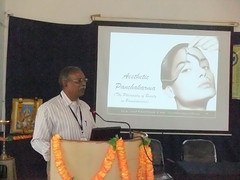“Ancient and today perception of embalming technique of human dead body”
What is Embalming?
It is a temporary preservation of a dead human being. This process is accomplished by a surgical technique of injecting chemical solutions in to the deceased’s vascular system, thus producing a natural life – like appearance after the injecting for a longer period. This process dramatically retard’s tissue decomposition creating a time frame for a viewing and /or funeral service.
The necessity of embalming is may depend on such factors as whether the family selected a service with a public or private viewing of the body with an open casket; if the body is going to be transported by air or rail for long distance; or because of the length of time prior to the burial or cremation.
History of embalming –
1) Embalming history in Egypt –
Egypt is attributed which being the land where embalming began. During the period from 6000 BC to 600 AD approximately 400,000,000 bodies were mummified. In Egypt embalming will be carried out for two reasons.
a. Religious:
Greek historian’s Herodotus maintained that the Egyptian’s were the first citizens to think in the immortality of the soul. They thought, the soul would never fully forsake the body as long as the body remained intact. The purpose of embalming that the soul could return it after the completion of the circle. This “circle of necessity” was a 3,000 year journey the soul was required to arise make before it could return to the body.
b. Sanitation:
The writer Cassius maintained that embalming was developed to which provide a solution to the problem of trying to bury the dead in the Nile valley which would be inundated on a frequent basis.
Egyptian Embalming method –
The Egyptian embalmers were members of the priesthood. Some believe that there embalming is a “lost art”. Much of their success was undoubtedly due to the dry hot climate. Heat and lack of moisture are natural enemies to bacterial survival and growth. The Egyptian’s practiced three methods of embalming based upon the wealth of the individual. The cheapest method was reserved for the poorest class of people which made about 80% of the Egyptian population. It basically consisted of immersion in the natron solution.
The most expensive method was comprised of five steps.
STEP 1: The removal of the Brain and the cranial cavity is repacked with resin.
STEP 2: The intestinal organs were removed through an abdominal incision. The organs were either washed and mixed with resin’s and spices and returned to the body or were placed in separate burial vessels called canopic jars.
STEP 3: The body was immersed in natron (sodium salt). The caustic action of the solution would cause the fingernails and toe nails to be removed. They were replaced in keeping with the belief that he body must be intact. The immersion lasted for 20-70 day’s.
STEP 4: Dehydration method. The body was cleansed, straightened and allowed to dehydrate directly from the sun.
STEP 5: Wrapping. The body will be wrapped by about 1200 yards of 3 ¼ inch bandage. The gum or glue held the cloth together and helped in fitting it around the body. The body was then placed in a sarcophagus and returned to the family.
Other practices of embalming –
Babylonians, Persian, and Syrians preserved their dead body by placing in jars of honey or wax. Decomposition was prevented by depriving the bacteria in the body of air.
The Greeks believed that the deceased must make a journey across the river Styx to the land of eternity. A coin was placed in the mouth of the deceased to pay passage over the river. A cake of honey was placed next to the body to appease the three headed dog,
The early Christians derived their burial customs from the Greeks, Romans and Jews. They followed the strong Jewish tradition of burial with no embalming.
Influence of Scientific Developments –
During the “Dark ages” in Europe, embalming was usually not practiced. During this period, great advances were being made in medicine and bodies were needed for the dissection purposes, so some embalming was done. The discoveries made in the world of medicine would have a great influence in the development of modern embalming technique.
Leonardo Davinci (1452-1519) – Prepared hundreds of anatomical plates as a result of his dissection of the human body. He undoubtedly used arterial injection to preserve the specimens.
Dr. Frederick Raysch (1665-1717) – He is generally considered the father of embalming with his discovery of the first successful system of arterial embalming.
Dr. Thomas Holmes (1817-1900) – He is generally considered the father of modern embalming. He experimented with preservation chemicals while working as a coroner’s assistant in New York.
Dr. William Hunter (1718 – 1783) – The first successfully adopts arterial injection as a means of preservation.
Alexander Butlerov (1828 – 1866) and Wilhelm von Hofmann (1818 – 1892) are credited with discovery of formaldehyde.
Dr Thomas Holmes (1817 – 1900) – He considered the father of modern embalming. He experimented with preservative chemicals.
Early American Embalming –
Modern embalming starts during the civil war period. Dr Thomas Holmes was captain in Washington in the Army Medical Corps. That period he embalmed many army officers killed in battle. Later Holmes resigned the commission and started embalming to the public.
Modern Embalming –
The first embalming preparation were arsenic solution that were rapidly replace when formaldehyde become available. The modern method of embalming is defined as the disinfection of preservation of the dead human body. Embalming is performed for three reasons.
1) The primary purpose of embalming is disinfection. While some pathogens die soon after the death of the host, it is also true that many dangerous organisms have the ability to survive for long periods of time in dead tissue.
2) The second purpose of embalming is preservation. The prevention of putrefaction and decomposition allows the disposition of the remains by burial, cremation, or entombment to take place with out the odors or other unpleasantness that would accompany an uncared for remains.
3) The third purpose of embalming is restoration. Returning the body to a life like appearance has received many critics, but the custom of viewing the body after death in a state of rest remains a practice of proven psychological worth. The modern embalming has been shown to be able to keep a body intact for decades.
Embalming is accomplished by a chemical “fixation” of the cell protein. Formaldehyde basically reacts with the soluble albumins in the ell and converts them to albuminoids or gels. At the same time, the bacteria are destroyed, thus halting or at least delaying decomposition.
The embalming fluid is both a disinfectant and a preservative. The fluid injected in to the arterial system by an electric pump, while the blood is forced out of the body. In effect, the blood is replaced with a disinfectant and preservative solution.
Steps to preparation of embalming the body –
The body is placed in a supine position on the embalming table. The body is washed, disinfected and face is shaved as necessary.
The eyes are closed. This is usually accomplished with a small curved plastic disc called an “eye cap” placed under the eyelid. Perforations in the cap help hold the eye lid in place.
The mouth is closed. This is usually accomplished by the placing on a specially designed “tack” in the upper jaw. Each tack has a fine wire attached, by twisting the two wires together, the jaw is thus closed and the lips are set to the natural.
The embalming solution is prepared; an incision is made over the carotid artery (carotid triangle, neck region) or over the femoral artery (femoral triangle in the thigh region). The artery and veins are located and isolated.
The fluid is injected in to the artery under pressure by the embalming machine. As the blood is displaced by the fluid going in. The pressure forces the embalming fluid in to the capillaries and eventually to the cells of the body.
After completion tubes are removed and incision sutured. The abdominal cavity is treated by the use of a hollow tube called a trocar that is used to aspirate gasses and liquid contents under suction. A preservative chemical is introduced.
The body is again washed and cream or glycerin is placed on the hands & face to prevent dehydration. The hair is shampooed & the finger nails are cleaned and body is covered with a sheet.
Cosmetics are later applied to replace the natural colour removed by the embalming process, much of which is created by blood in facial capillaries that is no longer present. In the case of women, cosmetics used in life may also be used to recreate the “look” the person had during life.
Embalming Technique –
The modern practice of embalming utilizes the so called “Arterial embalming” technique.
Arterial embalming consists of the injection of an embalming fluid in to the arterial system of the cadaver.
The cadaver is washed with any antiseptic solution and rinsed thoroughly with running water; the external genital area is covered with a piece of cloth or towel. The body is set in the anatomical position with hands turn downward. The nasal and oral cavities may be packed with cotton to avoid leakage during or after embalming. This is done to retain all chemicals and fluids for better fixation.
A small incision is made on the superior border of the sternoclavicular notch. The common carotid artery is exposed by cleaning the fascia of the artery to allow movement and space for the cannula which is inserted in to it .when the carotid artery is raised with aneurism hooks, two pieces of ligature are placed around the artery with forceps to hold the cannula in place while embalming. This is done to help avoiding leakage or release of the tube due to pressure exerted by the embalming machine. The common carotid artery is incised about 4 cm long any blood clots present are removed with forceps. An L- shaped cannula is then inserted in to the carotid via the slit and securely with string.
The L- shaped cannula is connected to polyethylene tubing which it connected to the gravity embalming tank located above the cadaver. Before the embalming fluid is injected, the air is removed from the connecting tube to avoid possible airlocks produced by the vessels of the cadaver during the injection of the fluid. Injection periods vary in each case taking 8 to 24 hours. The variability is due to the ability of the body to accept the fluid at its own rate. The fluid dispersing into the vascular system
Embalming fluid –
|
||
OR
|
||
During embalming, a number of small whitish splotches appear on the skin in the region, most effectively embalmed and then they spread peripherally. This splotching effect of embalming can be used to determine the effectiveness of the embalming. Splotches usually disappear within several hours without leaving any trace. Any region of the body not exhibiting this typical splotching is directly injected with embalming fluid with a hypodermic needle under pressure until the tissue in that region becomes hard enough (Bradbury,1978). A number of blisters may appear over certain areas of the body surface. When blisters do appear, it indicates that the pressure of the injecting fluid is too high.
Any part of the body not receiving enough fluid, generally the lower extremities, back and gluteal region require additional management. The extra fluid may be injected with a 25cc syringe and a 14 gauge needle.
The body is then turned on its back, the feet, legs; thigh, hand, forearm, abdomen, thorax, and face are then injected as needed. When injecting these areas it is best to insert the needle at a higher point than the injecting area to keep the fluid from leaking out.
While doing embalming procedure, protective glasses, a mask, and gloves are essential to ware. The exposure of harmful chemicals to the embalmer is greater at this time due to the direct injection and leakage that may occur. Water is kept running on the table at all times during the hypodermic embalming.
Wetting agent –
Without proper preserved cadaver, the study of a dissected cadaver is difficult to undertake. The additional care is taken to facilitate the better preservation of cadavers for future anatomical studies. The wetting agent is used to saturate the tissues because it helps prevent drying during dissection. The wetting agent consist Propylene glycol, liquefied phenol and isopropyl alcohol. The wetting agent is made available to all anatomy laboratory students to allow them to keep their specimen’s tissues soft and flexible for study in the anatomy laboratories.
Injection points –
There are only two efficient primary injection points, the femoral and common carotid arteries. Each injection site is considered on a case by case basis.
The femoral artery is the primary injection point of choice because it is the largest vessel available. The disadvantages of the femoral artery is that vessel is deep in obese cases, making it difficult locate and to rise. Its many branches and tributaries create possibilities of leakage. This may lead to poor fluid distribution and a poorly embalmed body.
An injecting through the right common carotid artery is recommended and care is taken not to push the canula beyond the bifurcation which could lead to short circuiting and lack of fluid distribution in the shoulder, hands, and arms. The advantage of this injection point is that it ensures direct fluid distribution to the face. The fluid can be injected downward where pressure is not as much of a factor. The extremities, thorax, viscera, and lower extremities can be embalmed properly if there is no blockage within the vascular system.
Formaldehyde –
It is known that too much formalin causes unnecessary irritation of the skin, nose and eyes of the person dissecting and may create troubles. Formalin (37%formaldehyde) hardens the tissues quickly and tends to make the embalmed body stiff and hard if used in excess.
Caution regarding formaldehyde –
Individuals who work with human cadavers after or during embalming may be exposed to a variety of hazardous. Formaldehyde has been recognized for some time as an irritant affecting the mucous membranes of the respiratory tract and eyes. Some individuals may develop increased sensitivity to formaldehyde after initial exposure.
More recently formaldehyde has been shown to cause nasal squamous cell carcinoma in exposed rats. Based on toxicological and epidemiological evidence, the Occupational Safety and Health Administration (OSHA) has found that exposure to formaldehyde may be associated with cancers of the lungs, brain and bone marrow. The U.S Environmental protection Agency (EPA) classifies formaldehyde as a probable human carcinogen.

PROCEDURES OF EMBALMING AND CANOPIC JARS
By –
1. Dr Giridhar M Kanthi. Prof & Head Dept of Anatomy S D M C A Udupi.
2. Dr. Sibgathulla Sharif 2nd year P G Scholar S D M C A Udupi.
3. Dr Vipin 2nd year P G Scholar S D M C A Udupi.
Jnana Srotas_Magazine … Shareera Research … AyOL Shareera… Members


























Sir the article is highly informative. Sir why can not you add the original photos instead of cartoons ?
Dear Sir
Thank you for comment, we could not get the earlier original photos The recent photos may add which we are doing the embalming method in our S D M Ayurveda college udupi Institute. we will add original photos shortly,
Thank you
To Whom It May Concern,
I am going to give a class on “Death &Dying” at Park University in San Antonio, TX and would your staff have any information on video’s or CD’s on embalming. Our class starts on the first week of Oct and need the information as soon as possible so our finance department can purchase the material.
Thank you for your help and I hope to hear from you soon.
Thank you,
Gregory V. Lopezieo, PhD
Sociologist
Please place such material and comments as information in technoayurveda community – http://technoayurveda.ning.com/
Sir, this article is a real source of interest. As I’m also a student of Ayurveda I can feel the need for gaining the knowledge about Sharir Rachna.
I’ll also try to send you my compilation on the subject.
i love this, infact it is a welcomed development